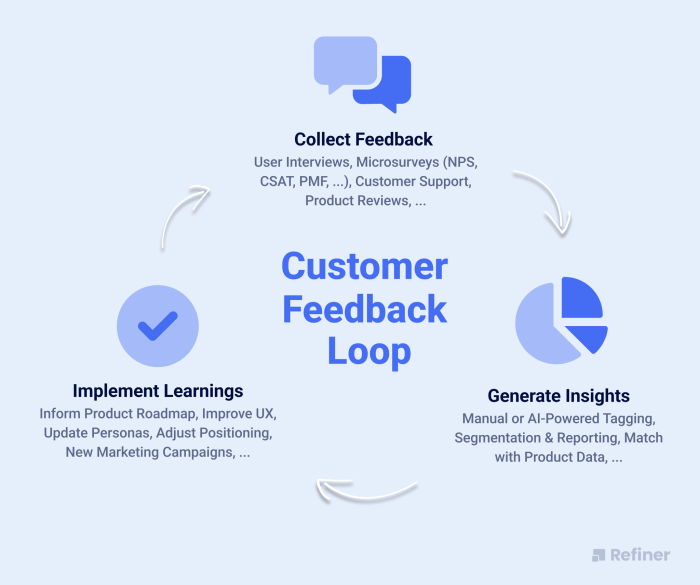Building a Customer Feedback Loop kicks off our journey into the realm of customer-centric strategies, where feedback reigns supreme in shaping successful businesses. Dive into the world of customer insights and watch your business flourish.
Importance of Building a Customer Feedback Loop
Establishing a customer feedback loop is crucial for businesses as it provides valuable insights into customer preferences, pain points, and overall satisfaction levels.
Driving Business Growth
Customer feedback can drive business growth by helping companies understand what customers truly want and need. By incorporating feedback into product development and service improvements, businesses can tailor their offerings to meet customer demands more effectively, leading to increased sales and customer loyalty.
Improving Products or Services
Actively listening to customer feedback allows businesses to identify areas for improvement and innovation. Whether it’s addressing product quality issues, enhancing customer service processes, or introducing new features based on customer suggestions, feedback helps businesses stay competitive and relevant in the market.
Long-Term Success
The benefits of actively listening to customer feedback extend to long-term success. By continuously engaging with customers, businesses can build strong relationships, foster trust, and create a loyal customer base. Additionally, feedback provides valuable data for strategic decision-making, enabling businesses to adapt to changing market trends and customer preferences over time.
Setting Up a Customer Feedback System: Building A Customer Feedback Loop
Setting up a customer feedback system is crucial for businesses looking to improve their products and services. By collecting feedback from customers, companies can gain valuable insights to make informed decisions and enhance the overall customer experience. Let’s dive into different methods for collecting customer feedback, creating feedback forms, and choosing the right feedback channels.
Different Methods for Collecting Customer Feedback
- Surveys: Sending out surveys to customers via email or through the company’s website is a common method to gather feedback. Surveys can be tailored to specific areas of interest and can provide quantitative data.
- Social Media: Monitoring social media platforms for customer comments, reviews, and direct messages can offer real-time feedback. Engaging with customers on social media can also encourage them to share their thoughts.
- Emails: Sending personalized emails to customers requesting feedback can be an effective way to collect detailed responses. Including open-ended questions can encourage customers to provide specific feedback.
Creating Feedback Forms that Encourage Detailed Responses
- Keep it simple: Ensure that the feedback form is easy to navigate and straightforward to complete. Avoid lengthy questionnaires that may deter customers from providing feedback.
- Include open-ended questions: Encourage detailed responses by including open-ended questions that allow customers to express their thoughts freely. This can provide valuable insights and suggestions for improvement.
- Provide incentives: Offer incentives such as discounts, coupons, or entry into a prize draw to encourage customers to fill out feedback forms. This can increase the response rate and provide more comprehensive feedback.
Choosing the Right Feedback Channels Based on the Target Audience
- Understand your audience: Consider the demographics, preferences, and behavior of your target audience when selecting feedback channels. Different age groups may prefer different communication methods.
- Use multiple channels: Utilize a combination of feedback channels to reach a wider audience. This can include online surveys, social media platforms, email campaigns, and in-person feedback sessions.
- Monitor feedback channels: Regularly monitor the chosen feedback channels to track customer responses and identify any trends or patterns. This allows companies to make timely adjustments and improvements based on customer feedback.
Analyzing and Organizing Customer Feedback

When it comes to customer feedback, analyzing and organizing the data is crucial for businesses to improve their products and services. By understanding what customers are saying, companies can make informed decisions to enhance the overall customer experience.
Effective Analysis of Customer Feedback Data, Building a Customer Feedback Loop
Analyzing customer feedback data involves looking for patterns, trends, and common issues that arise in the feedback. Businesses can use tools like sentiment analysis to gauge the overall sentiment of customers towards their brand. It’s important to not only focus on the quantity of feedback but also on the quality of the feedback provided.
Tips for Categorizing Feedback
When categorizing feedback, businesses should look for common themes or issues that customers are highlighting. Creating categories based on these themes can help in identifying areas that need improvement. It’s essential to be consistent in categorizing feedback to ensure that all data is organized effectively.
Significance of Organizing Feedback
Organizing feedback in a structured manner allows businesses to easily reference and take action on the feedback provided. By categorizing feedback based on common themes, businesses can prioritize areas that need attention. This structured approach ensures that feedback is not overlooked and that improvements are made where they are needed most.
Implementing Changes based on Customer Feedback

Implementing changes based on customer feedback is a crucial step in improving products or services. It involves prioritizing feedback, communicating changes effectively, and showcasing successful case studies where feedback led to significant improvements.
Prioritizing Feedback for Implementation
- Review all customer feedback systematically.
- Identify common themes or issues that are mentioned frequently.
- Rank feedback based on impact on customer experience or business goals.
- Consider the feasibility and resources required to address each piece of feedback.
Communicating Changes to Customers
- Be transparent about the changes being made based on feedback.
- Provide clear explanations of how customer feedback influenced the decision-making process.
- Utilize multiple channels such as email, website announcements, or social media to inform customers.
- Solicit feedback on the implemented changes to show customers their opinions are valued.
Successful Case Studies
Example 1: Company XYZ implemented a new feature suggested by customers through feedback, resulting in a 20% increase in user satisfaction.
Example 2: Restaurant ABC modified its menu based on customer reviews, leading to a 15% growth in repeat customers.
Example 3: Retailer DEF revamped its online shopping experience following customer feedback, doubling its online sales within a month.